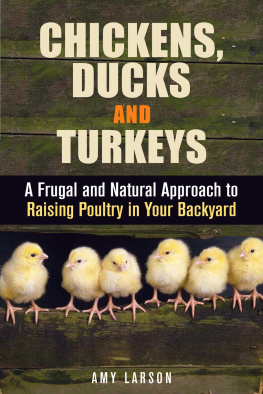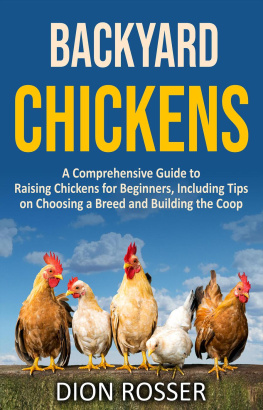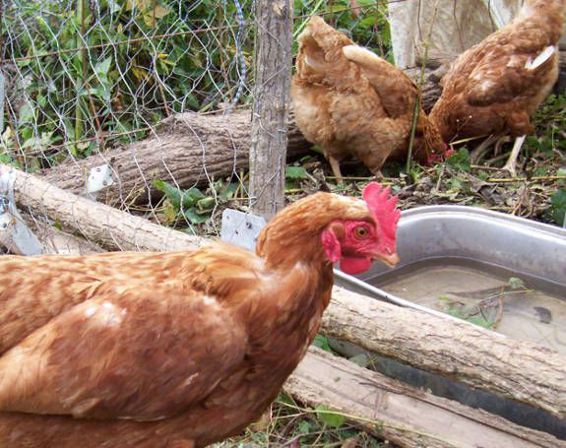TheWorking Chicken
byAnnaHess
First edition published 2008.All rights reserved.No part of this book may be reproduced in any form or by any electronicor mechanical means including information storage and retrievalsystems, without permission in writing from the author. The onlyexception is by a reviewer, who may quote short excerpts in a review.Visit my blog at www.waldeneffect.org, learn more about my chickens atwww.avianaquamiser.com, or learn about my books at www.wetknee.com.
Contents
What kind of chickens should I get?
Which color eggs are best?
Should I add a rooster to my flock?
She's so cute! Can I name her?
What should I feed my chickens?
What is the chicken's place in the farm ecosystem?
Introduction
When times get tough, people start buying chickens. Why? Because with a little bit of preparation, you can provide all of youregg needs and get a bit of meat too for a time expenditure of about 15minutes a day. If you plan well, you can sell enough eggs to payfor your chickens' feed and at least break even at the venture.This book gives you all of the information you need to get started withyour self-sufficient, working flock. It isn't for the backyardhobbyist who wants to show fancy chickens at the fair. It's notfor the big-scale producer who wants to make a lot of moneyeither. It's for the average person who would like to eat tastyeggs, enjoy the company of chickens, and kill a rooster now and thenfor dinner.This book skims the highlights so that you can become armed witheverything you need to know to get started in thirty minutes orless. Once you get into chickens, you'll probably want to learnmore about their behavior, how to make a fancy coop, and many moretopics. There are dozens of books and websites available on eachof these subjectsbut don't wait to read them before you buy yourfirst chickens! There's no time like the present to become theowner of a working chicken flock.
What kind of chickens should I get?
Short answer:Golden Comet.
Different breeds are suitable for different needs. Basically,chicken breeds can be divided into four categories:
- Cool-looking exhibition birds
- Prolific egg-layers
- Meat birds
- Dual purpose (egg and meat) birds
I recommend steering clear ofexhibition birds for the working flock, although they can be fun for kids or to have aspets. We have a White Cochin hen with beautiful feathers over herfeet, but she's not really suitable for tractor lifeshe's alwaysnapping on the perch while my working hens are scrabbling around in thedirt hunting bugs. (On the other hand, she makes a good mother.)The food industry has developed a few varieties that are extremelywell suited to egg-laying or to putting on weight quickly as meatbirds. The top varieties of egg, meat, and dual-purpose chickensare listed below:
- White Leghorn - egg-laying, white eggs
- Golden Comet - egg-laying, brown eggs
- Red or Black Sex-Links - egg-laying, brown eggs
- Rhode Island Reds - egg-laying, brown eggs
- Cornish Cross (White Cornish X White Plymouth Rock) - meat, reach 4-5lbs. in 6 weeks
- Plymouth Rocks - dual-purpose, good for meat and eggs
- Sussex - dual-purpose, good for meat and eggs
- Wyandottes - dual-purpose, good for meat and eggs
In the first edition of this book, I recommended the Plymouth Rocksince the breed has a reputation of being a good dual-purposebreed. However, after extensive experimentation, we discoveredthat a bird that's supposed to be good for everything is really goodfor nothing. We deleted the Plymouth Rocks from our flock andhave instead settled on raisingGolden Comets and Rhode Island Reds for eggs our feed costsplummeted when we switched over to the more efficient breeds.If you want to raise chickens for meat, the most popular meat variety is CornishCross . Unfortunately, this highly inbred strain has morethan its share of health problems, so raise them with care.To check out other varieties, I recommend the chicken breed selectortool at: www.mypetchicken.com/breedQuestions.aspx.
Which color eggs are best?
Shortanswer: Color doesn't matter.
Chickens lay eggs ranging in color from white through all shades ofbrown and even into greens and blues. The color eggs your hen lays dependson her breed . To quickly determine what color egg a henwill lay, check out the color of her earlobes:
- White earlobes mean white eggs.
- Red earlobes mean brown eggs.
Eggshell color doesn't affect thenutritional value of the egg in any way, but most people are willing to pay more for a brown eggthan a white egg so I recommend choosing a brown-egg-laying variety ifyou plan to sell any eggs. (You will want to sell some eggs during peak egg-laying seasons.)Green and blue eggs are laid by Ameraucana chickens and a few othervarieties. Adding an Ameraucana to your flock can sometimes be agood idea when selling eggs for the novelty effect, but the breed isn'ta good choice for the majority of your working flock since the hensdon't lay that many eggs.Although eggshell color doesn't affect the nutritional value of eggs,other factors do. An ongoing study by Mother Earth News shows that eggs from hens raised on grass not onlydevelop beautiful yellow yolks but are much better for younutritionally. Eggs from pastured poultry have been found to have as much as...
- 4 to 6 times as much vitamin D
- 1/3 less cholesterol
- 1/4 less saturated fat
- 2/3 more vitamin A
- 2 times more omega-3 fatty acids
- 3 times more vitamin E
- 7 times more beta carotene
...compared to supermarket eggs from hens raised in isolation.Read more at www.motherearthnews.com/eggs.aspx.
Check out the egg color of several common breeds atwww.ithica.edu/staff/jhenderson/chooks/chooks.html.
How many chickens should I get?
Shortanswer: Three hens per person.
The number of chickens you need depends on how much meat and howmany eggs you eat. We recommend starting out with an egg-layingflock that provides all your eggs along with an occasional meat bird.The size of your first flock is based on how many eggs your family eatsper year:
- An average person eats about 300 eggs a year.
- An average Golden Comet hen lays about 300 eggs per year (more inthe summer than winter.)
- Two hens is just about right for theaverage person.
If you choose a breed that's less efficient at laying eggs, you willneed to double the number of hens in your flock to get the same amountof eggs. And you might discover, as we did, that after you startraising your own wholesome eggs, you eat a lot more of them.Finally, keep in mind that your hens' eggproduction will slow down in the winter months andwhen the hens molt. I like to add an extra hen per person in thefamily to ensure that we still have eggs during these low egg-layingseasons. During high production times of year, we sell the extraeggs to our friends to pay for chicken feed. Depending on yourregion, you should expect to be paid anywhere from $2.50 to $4.50 perdozen for your pastured poultry eggs.





















